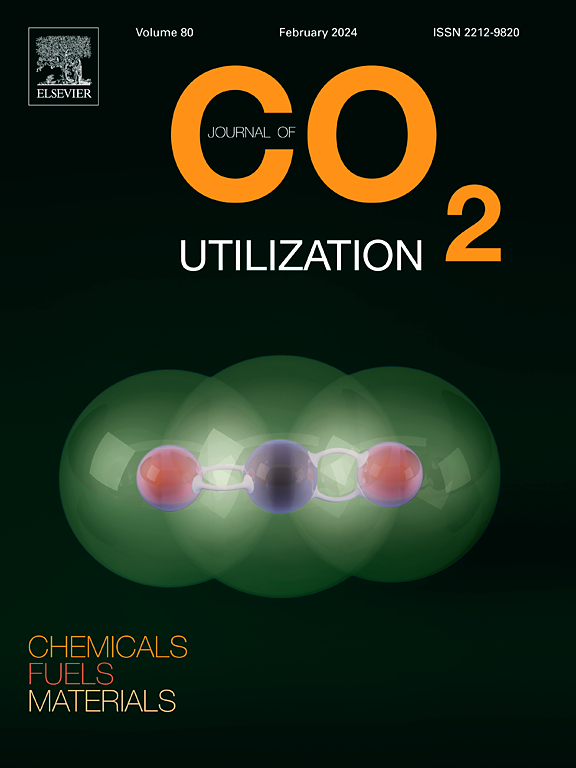利用铜/铬-腺嘌呤超分子组装的多孔金属有机材料从水中捕获二氧化碳
IF 8.4
2区 工程技术
Q1 CHEMISTRY, MULTIDISCIPLINARY
引用次数: 0
摘要
采用超分子金属有机多孔材料[CrCu6(μ-adeninato-кN3:кN9)6(μ-OH)6(μ-OH2)6](SO4)1.5 (Cu6Cr)对水中CO2的捕集性能进行了测试。该化合物的性质,不溶于水,灵活的超分子结构,以及在腺嘌呤配体上的质子位置,使其成为这项任务的潜在候选者。从水中捕获二氧化碳的实验测定采用了两种技术:首次采用磁支撑法和重力测量法。两种技术都验证了二氧化碳捕获,提供了互补的信息。磁支撑技术测量了被纳入多孔材料的质量(这取决于被捕获的化学形式:物理吸附,HCO3-或氨基甲酸酯),而重量测量则量化了Cu6Cr颗粒的水悬浮液中被捕获的二氧化碳的总质量,而不管这种捕获发生的化学形式。CO2(300 mL·min−1)在Cu6Cr颗粒的水悬浮液中起泡1 小时后,通过磁支撑和重量技术分别测量了捕获质量值22.3% %和17.1 %。这种差异是因为CO2被捕获为H2CO3,与腺嘌呤配体反应形成腺嘌呤/HCO3-对。这些值归一化为5.9 HCO3-和6.4 CO2分子/ Cu6Cr实体,接近理论值6,因为每个七聚体Cu6Cr实体有6个腺嘌呤配体。报告了CO2吸附等温线、吸附/解吸动力学和循环稳定性。动力学研究结果为ΔHads = -19.4 kJ/mol,明显低于其他CO2吸附剂。但循环稳定性有待提高。本文章由计算机程序翻译,如有差异,请以英文原文为准。
CO2 capture from water using a copper/chromium-adenine supramolecularly assembled porous metal-organic material
A supramolecular metal-organic porous material [CrCu6(μ-adeninato-кN3:кN9)6(μ-OH)6(μ-OH2)6](SO4)1.5 (Cu6Cr) has been tested for CO2 capture from water. The properties of this compound, insolubility in water, a flexible supramolecular structure, and protonable positions on the adeninato ligands, make it a potential candidate for this task. The experimental determination of CO2 capture from water was performed using two techniques: magnetic sustentation, for first time, and gravimetric measurements. Both techniques verified the CO2 capture providing complementary information. The magnetic sustentation technique measures the mass being incorporated into the porous material (which depends on the chemical form in which is being captured: physisorption, HCO3- or carbamate), whereas the gravimetric measurement quantifies the total mass of CO2 being captured in the aqueous suspension of the Cu6Cr particles regardless the chemical form in which this capture takes place. After 1 hour of CO2 bubbling (300 mL·min−1) into the aqueous suspension of Cu6Cr particles, capture mass values of 22.3 % and 17.1 % are measured by magnetic sustentation and gravimetric techniques, respectively. This difference is because the CO2 is captured as H2CO3 that reacts with the adeninato ligands to form adenine/HCO3- pairs. These values normalize to 5.9 HCO3- and 6.4 CO2 molecules per Cu6Cr entity, which are close to the theoretical value of 6, because of the six adeninato ligands per heptameric Cu6Cr entity. CO2 adsorption isotherms, adsorption/desorption kinetics and cycling stability are also reported. Kinetic studies provide a ΔHads = -19.4 kJ/mol, which is a significantly lower than other CO2 adsorbents. However, the cycling stability needs to be improved.
求助全文
通过发布文献求助,成功后即可免费获取论文全文。
去求助
来源期刊

Journal of CO2 Utilization
CHEMISTRY, MULTIDISCIPLINARY-ENGINEERING, CHEMICAL
CiteScore
13.90
自引率
10.40%
发文量
406
审稿时长
2.8 months
期刊介绍:
The Journal of CO2 Utilization offers a single, multi-disciplinary, scholarly platform for the exchange of novel research in the field of CO2 re-use for scientists and engineers in chemicals, fuels and materials.
The emphasis is on the dissemination of leading-edge research from basic science to the development of new processes, technologies and applications.
The Journal of CO2 Utilization publishes original peer-reviewed research papers, reviews, and short communications, including experimental and theoretical work, and analytical models and simulations.
 求助内容:
求助内容: 应助结果提醒方式:
应助结果提醒方式:


